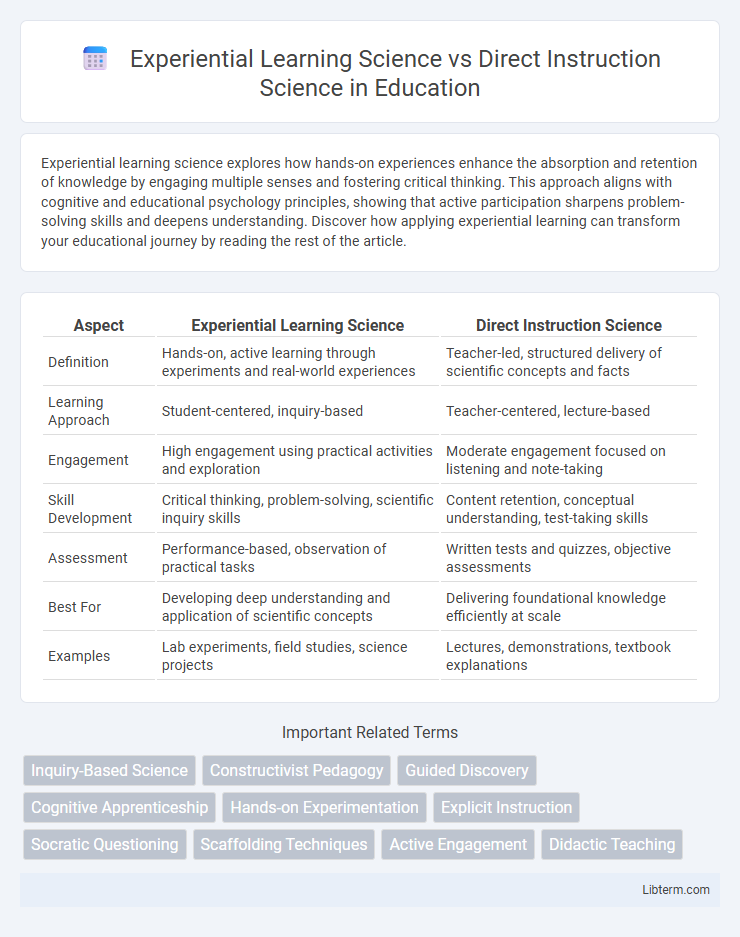Experiential learning science explores how hands-on experiences enhance the absorption and retention of knowledge by engaging multiple senses and fostering critical thinking. This approach aligns with cognitive and educational psychology principles, showing that active participation sharpens problem-solving skills and deepens understanding. Discover how applying experiential learning can transform your educational journey by reading the rest of the article.
Table of Comparison
| Aspect | Experiential Learning Science | Direct Instruction Science |
|---|---|---|
| Definition | Hands-on, active learning through experiments and real-world experiences | Teacher-led, structured delivery of scientific concepts and facts |
| Learning Approach | Student-centered, inquiry-based | Teacher-centered, lecture-based |
| Engagement | High engagement using practical activities and exploration | Moderate engagement focused on listening and note-taking |
| Skill Development | Critical thinking, problem-solving, scientific inquiry skills | Content retention, conceptual understanding, test-taking skills |
| Assessment | Performance-based, observation of practical tasks | Written tests and quizzes, objective assessments |
| Best For | Developing deep understanding and application of scientific concepts | Delivering foundational knowledge efficiently at scale |
| Examples | Lab experiments, field studies, science projects | Lectures, demonstrations, textbook explanations |
Understanding Experiential Learning Science
Experiential Learning Science emphasizes active engagement and hands-on activities, enabling learners to construct knowledge through personal experience and reflection. This approach fosters deeper conceptual understanding and critical thinking by integrating real-world contexts into scientific inquiry. Studies show that students involved in experiential learning demonstrate higher retention rates and improved problem-solving skills compared to traditional Direct Instruction Science methods.
Key Principles of Direct Instruction Science
Direct Instruction Science emphasizes structured, teacher-led lessons with clear, specific learning objectives and systematic skill development, ensuring consistent content delivery. Key principles include explicit teaching of scientific concepts, frequent assessment to monitor student progress, and immediate feedback to reinforce understanding. This method prioritizes mastery of foundational knowledge through repetition and guided practice, contrasting with the exploratory nature of Experiential Learning Science.
Historical Context of Both Approaches
Experiential learning in science traces back to John Dewey's early 20th-century philosophy emphasizing learning through experience and reflection, contrasting with Direct Instruction's roots in behaviorist theories pioneered by B.F. Skinner in the mid-1900s, which focus on structured, teacher-led delivery of content. Dewey's approach promotes active engagement and discovery, while Direct Instruction arose from a need for efficient, standardized teaching methods proven effective in improving student achievement on measurable outcomes. Understanding these historical contexts highlights the evolution from constructivist, learner-centered experiences toward systematic, outcome-driven instruction within science education.
Learning Outcomes: Experiential vs Direct Instruction
Experiential learning in science fosters critical thinking and problem-solving by engaging students actively in experiments and real-world applications, resulting in higher retention and deeper understanding of scientific concepts. Direct instruction focuses on structured, teacher-led lessons that efficiently deliver foundational knowledge and procedural skills, often leading to quicker acquisition of basic facts and standardized test performance. Studies show experiential learning enhances long-term learning outcomes and creativity, while direct instruction excels in ensuring consistent mastery of core science content.
Cognitive Processes Engaged in Each Method
Experiential Learning Science actively engages cognitive processes such as critical thinking, problem-solving, and metacognition by allowing learners to explore scientific concepts through hands-on activities and real-world applications. In contrast, Direct Instruction Science emphasizes the cognitive processes of memorization, information retention, and sequential reasoning through structured lessons and explicit teaching of scientific facts and procedures. Both methods activate different neural pathways, with experiential learning fostering deeper conceptual understanding and direct instruction supporting foundational knowledge acquisition.
Classroom Dynamics and Student Engagement
Experiential learning science transforms classroom dynamics by promoting active exploration, hands-on experiments, and real-world problem-solving, which significantly increases student engagement and motivation. Direct instruction science emphasizes structured, teacher-led explanations and step-by-step guidance, often resulting in more uniform understanding but potentially less interactive participation. Integrating experiential techniques with direct instruction can balance conceptual clarity with dynamic engagement, fostering deeper comprehension and sustained interest in scientific inquiry.
Assessment Methods and Evaluation
Experiential Learning Science uses formative assessments such as observation, reflective journals, and performance-based tasks to evaluate students' hands-on engagement and conceptual understanding. Direct Instruction Science relies heavily on summative assessments like standardized tests, quizzes, and written exams to measure factual knowledge and procedural skills. Both methods emphasize feedback, but Experiential Learning prioritizes continuous, applied evaluation while Direct Instruction focuses on discrete, knowledge-recall assessments.
Strengths and Limitations of Experiential Learning
Experiential Learning Science emphasizes hands-on activities and real-world problem-solving, enhancing retention and critical thinking by engaging students actively in the learning process. Its strengths include fostering deeper understanding, promoting creativity, and developing practical skills applicable to scientific inquiry. However, limitations involve the potential for misconceptions without proper guidance, time-intensive preparation, and challenges in assessing standardized knowledge outcomes.
Advantages and Drawbacks of Direct Instruction
Direct instruction in science offers structured lessons that promote efficient knowledge acquisition and clear learning objectives, making it ideal for foundational concepts and standardized assessments. However, this method often limits student creativity and critical thinking by emphasizing memorization over exploration and may reduce engagement compared to experiential learning approaches. Despite its drawbacks, direct instruction provides consistent content delivery and measurable outcomes crucial in large or diverse classrooms.
Choosing the Right Approach for Science Education
Experiential Learning Science emphasizes hands-on, inquiry-based activities that foster critical thinking and deeper understanding of scientific concepts through real-world applications. Direct Instruction Science relies on structured, teacher-led lessons focusing on clear, step-by-step explanations and practice to efficiently build foundational knowledge and skills. Selecting the right approach depends on educational goals, student needs, and curriculum requirements, balancing engagement with mastery for optimal science learning outcomes.
Experiential Learning Science Infographic

 libterm.com
libterm.com